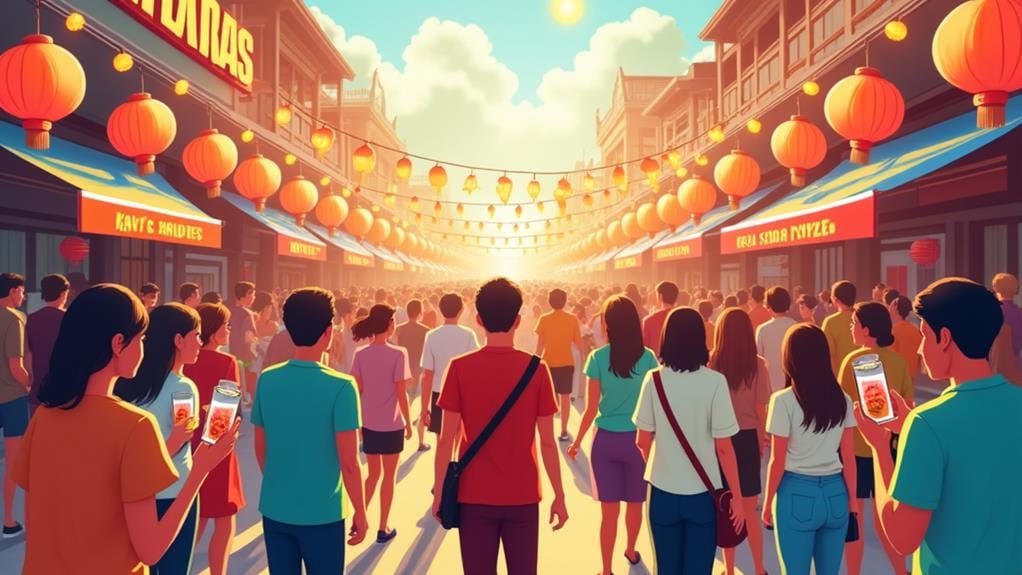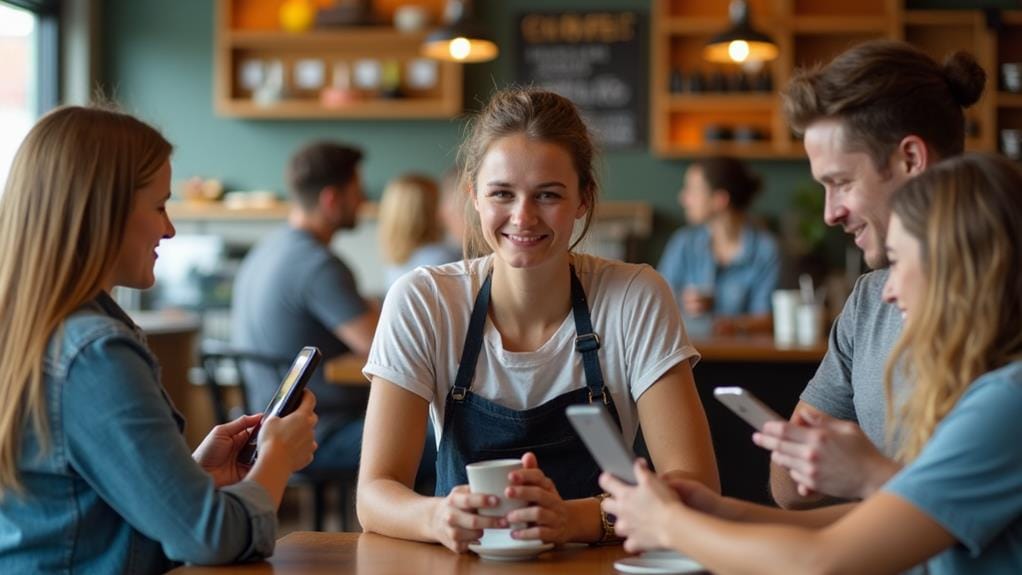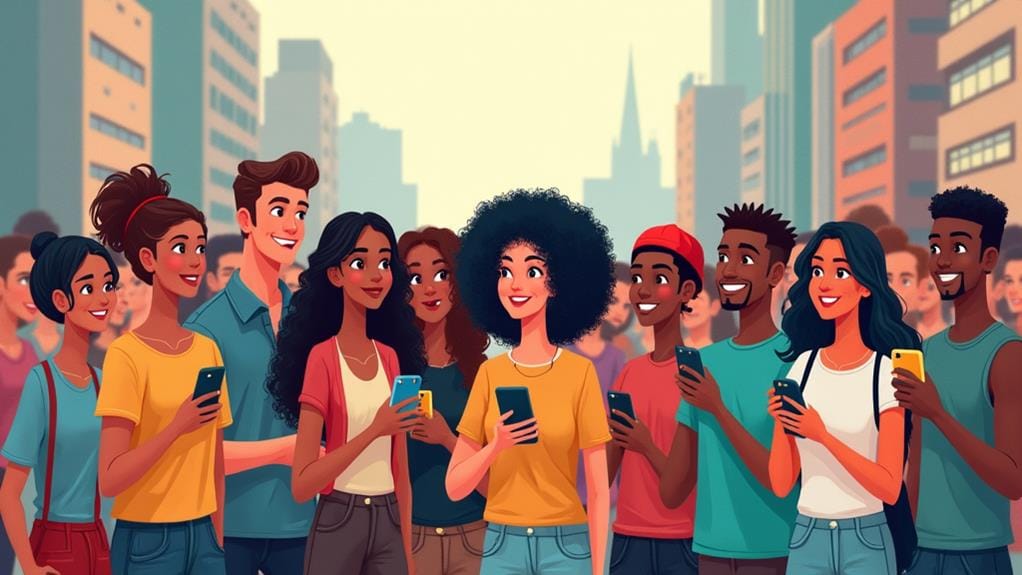

A medida que se esfuerza por conectar con los consumidores locales en las redes sociales, es crucial captar las impulsores psicológicos detrás de sus preferencias y decisiones de compra. Su respuestas emocionales, normas culturalesy identidad social desempeñan un papel importante a la hora de determinar su comportamiento. Si conoce estos factores, podrá adaptar sus contenidos y estrategias de marketing para que resuenen entre su público local. Por ejemplo, utilizando idioma local y los elementos visuales pueden fomentar el sentido de comunidad e impulsar la participación. Al reconocer la importancia de la relevancia cultural, estarás mejor preparado para adaptar tu enfoque y reforzar tu conexión con los consumidores locales, lo que se traducirá en estrategias de redes sociales más eficaces.
Mientras exploras el mundo de comportamiento del consumidor local, redes sociales surge como una plataforma esencial para comprender los entresijos de la psicología del consumidor local.
Descubrirá que el comportamiento de los consumidores locales está muy influido por normas culturales e identidad social, con un 33% de estadounidenses que utilizan las redes sociales para descubrir nuevos productos y marcas. Además, efectivamente adaptar los productos y la comercialización a las preferencias locales puede mejorar considerablemente niveles de compromiso.
Las respuestas emocionales desempeñan un papel vital en la formación de las preferencias de los consumidores locales, ya que los contenidos que resuenan con las emociones de la audiencia tienden a aumentar la participación y el intercambio.
El análisis de los comentarios y opiniones en las plataformas de medios sociales puede revelar conocimientos culturales y motivaciones emocionales que subyacen al comportamiento de los consumidores, lo que mejorará su estrategia de marketing. estrategias de marca adaptados a las preferencias locales.
Puede obtener valiosos cliente[3] perspectivas de compromiso en línealo que contribuye directamente a comprender la psicología del consumidor local. De hecho, 90% de las empresas afirman haber obtenido más información sobre sus clientes gracias a la interacción en línea.
Ha adquirido un conocimiento más profundo del comportamiento de los consumidores locales y de la importancia de las redes sociales en la configuración de sus preferencias.
Ahora es el momento de desarrollar estrategias de marketing eficaces que respondan a sus motivaciones y deseos. Elaborar contenidos atractivos es vital para crear un sentimiento de comunidad en las redes sociales.
Para conseguirlo, comprender la cultura local es esencial, ya que informa sobre el uso de la jerga y los símbolos relevantes que resuenan con su audiencia.
Para crear un marketing impactante, considere las siguientes estrategias:

El poder de actos culturales y tendencias en redes sociales no se puede exagerar, sobre todo cuando se trata de atraer a los consumidores locales. Si se aprovechan las redes sociales para sacar partido de los eventos culturales, se puede crear un profundo impacto en la experiencia del consumidor, fomentando un sentido más profundo de conexión y comunidad.
Eventos que tengan resonancia entre su público objetivo, como fiestas locales o celebraciones culturales, pueden destacarse para aumentar el compromiso y mostrar la implicación de su marca en la comunidad. aprovechar los acontecimientos locales.
Cuando elabora contenidos acordes con las costumbres y celebraciones locales, demuestra su compromiso con sensibilidad culturallo que puede provocar un aumento fidelidad a la marca.
Utilizar el lenguaje local, modismos y elementos visuales que reflejen los puntos de referencia de la comunidad crea una sensación de familiaridad, por lo que es más probable que los consumidores resuenen emocionalmente con su marca.
Comprender la psicología del consumidor
Profundizar en los entresijos de la psicología del consumidor revela el profundo impacto que las normas culturales y la identidad social tienen en el comportamiento de los consumidores locales. Al analizar las interacciones en las redes sociales, descubrirás las complejas capas de las decisiones de compra y la lealtad a la marca dentro de comunidades específicas.
Para entender realmente a los consumidores locales, hay que comprender los factores emocionales y psicológicos que subyacen a sus preferencias. La participación activa en las redes sociales puede aumentar la visibilidad local y reflejar los valores culturales de la comunidad, influyendo en los comportamientos de compra y la percepción de la marca.
Además, las redes sociales influyen en el SEO gracias a un mayor conocimiento de la marca, esencial para conectar con el público local.
Tres aspectos clave de la psicología del consumidor que hay que examinar:

Numerosas marcas luchan por establecer una conexión genuina con los consumidores locales en las redes sociales, a menudo debido a la falta de comprensión de los valores culturales y tradiciones únicos de la comunidad. Para superar este reto, hay que desarrollar estrategias que reflejen auténticamente la cultura y las tradiciones locales, fomentando la confianza y la credibilidad entre los consumidores locales. Este enfoque conduce a conexiones emocionales más fuertes con su marca.
| Estrategia | Resultado |
|---|---|
| Adaptar los mensajes para incorporar los valores culturales | Mayor compromiso y resultados de marketing impactantes |
| Utilizar las redes sociales para mantener conversaciones bidireccionales | Mayor fidelidad a la marca y compromiso con la comunidad |
| Participar en actos y debates comunitarios | Compromiso demostrado con la sensibilidad cultural y la autenticidad |
| Analizar los comentarios de las redes sociales | Descubrir los factores psicológicos que impulsan el comportamiento de los consumidores locales |
| Desarrollar contenidos culturalmente sensibles | Conexiones emocionales más fuertes con los consumidores locales |
Al establecer una sólida presencia de marca comunitaria en las redes sociales, estará mejor preparado para generar confianza y credibilidad entre los consumidores locales. Esto implica crear contenidos que reflejen con autenticidad la cultura y las tradiciones locales, fomentando conexiones emocionales que impulsen la lealtad y los lazos comunitarios.
Compromiso con el público local a través de contenidos específicos puede mejorar enormemente la visibilidad y relevancia de su marca. Si adapta su mensaje para que resuene con los valores y preferencias culturales, atraerá a su público local con mayor eficacia, lo que redundará en una mayor fidelidad y promoción.
He aquí tres ventajas clave de crear una presencia de marca comunitaria:

Los cambios constantes paisaje cultural representa un reto para las marcas que quieren seguir siendo relevantes y estar conectadas con los consumidores locales.
Mientras navega por este terreno cambiante, querrá recurrir a datos de las redes sociales para conocer mejor el comportamiento de los consumidores. Esto le ayudará a identificar y responder a nuevas tendencias culturales y preferencias de forma eficaz.
El 33% de los estadounidenses utiliza las redes sociales para descubrir nuevos productos, por lo que es esencial adaptar los mensajes a los cambiantes intereses culturales.
A la hora de medir el éxito y la repercusión de sus esfuerzos en las redes sociales, es fundamental realizar un seguimiento de los indicadores clave de rendimiento que van más allá de las meras métricas de vanidad.
Hay que analizar los comentarios en las redes sociales para conocer a fondo la psicología del consumidor local e identificar los factores emocionales y psicológicos que impulsan las decisiones de compra.
Para medir eficazmente el éxito de sus campañas en las redes sociales, céntrese en las siguientes métricas:
Observará que las redes sociales influyen en el comportamiento de los consumidores de cuatro maneras: generando confianza a través de la prueba social y el marketing personalizado, fomentando la fidelidad a la marca mediante la conexión emocional y la participación de la comunidad, aprovechando el impacto de las personas influyentes e impulsando las compras a través de promociones específicas.
Cuando navegas por las redes sociales, te mueve el deseo de conexión social, compromiso emocional y expresión de identidad. También te influye la miedo a perderse algo[1]En la actualidad, las empresas se ven obligadas a buscar la validación social y a hacer frente a la sobrecarga de información, al tiempo que cultivan la lealtad a la marca.
A la hora de tomar decisiones de compra, nos vemos influidos por prejuicios cognitivos, desencadenantes emocionales y pruebas sociales. Las dinámicas de grupo y la expresión de la identidad también influyen en tus elecciones y, en última instancia, impulsan la toma de decisiones y la fidelidad a la marca a través de fuerzas psicológicas sutiles pero poderosas.
Comprenderá la psicología del consumidor reconociendo los sesgos cognitivos y los desencadenantes emocionales que impulsan los procesos de toma de decisiones, analizando cómo los factores de confianza, la prueba social y las influencias culturales determinan la percepción de la marca, y empatizando con las necesidades y los deseos de los consumidores.